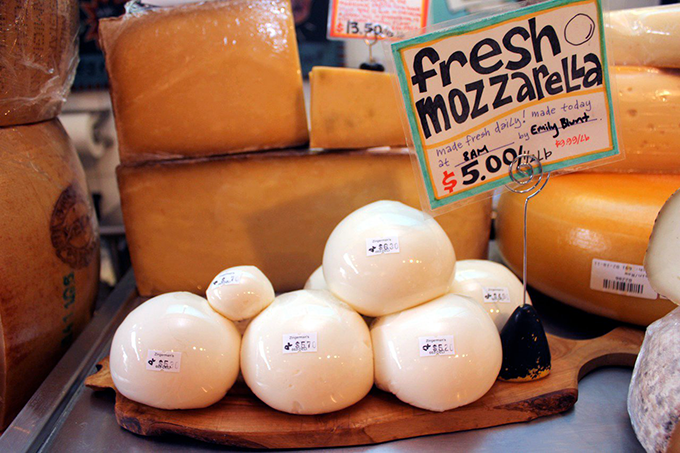Making Mozzarella

Maddie LaKind shares a cheesy story
People choose to start their mornings in all sorts of ways. Some opt for a cup of coffee and the paper. Some prefer an intense workout. Some even choose to wake up and reflect through writing or meditation. My mornings always start with mozzarella—that is mozzarella making rather than mozzarella eating. Although, I wouldn’t be opposed to the latter.
For nearly as long as I’ve worked in Zingerman’s Deli retail, the preparation of mozzarella has been the primary task on my morning checklist. Each day, between 7:00am and 8:00am, I (or any of the other few who have chosen to embark on the crazy journey of mastering “mozz”) turn a big hunk of curd into individually portioned servings of milky, mildly salty, cheesy goodness.
Just like jam, or pie, or any number of other well loved, but labor-intensive food classics, mozzarella is finicky to say the least. I always think about it like a math problem of sorts: all of the elements—heat, water, time, motion—must come together in just the right ratios to make a successful mozzarella. Some batches of mozzarella might be considered good by many standards, but that’s never really what I’m looking for. I want mozzarella that makes people swoon, that puts even the sweetest, and most succulent heirloom tomatoes to shame, the kind of mozzarella that people actively seek out, that brings them back. This has been my mozz quest since the very beginning.
The mozzarella making process is an inherently simple one. All you are really doing is heating up curd and bringing it together into a giant mass so that you can pull pieces off and shape them into individually portioned balls. Once shaped, the cheese is soaked in a salt-water brine to firm up and add that lovely salty flavor. Sounds easy enough, right? The catch is that you are essentially racing against the clock during this whole process. Either too little, or too much time can lead to a less than ideal mozzarella. Heating the curd too quickly will lead to the excretion of too much milk fat, yielding a dry and chewy texture. And if the curd sits for too long in the hot water, it will simultaneously lose milk fat and melt, creating a slippery mass of curd that ultimately yields a final product that’s too dry. So much for an inherently simple process, huh?
I think what I’ve realized about mozzarella making, as with any art form, is that the entire process is informed by practice, trial, and error. I’m pretty sure you have to make about 30 batches of botched mozzarella before you achieve your ideal desired product. For many people, this sort of process is completely unappealing. Why would you want to invest so much time in something that takes so long to give you something delicious in return? For me, I like the challenge. I like that it’s not always easy. I like that you have to use your senses and intuition to create the best possible mozzarella. I like that I learn something new about the process with every batch I make. And I really can’t complain about tasting mozzarella five days a week!
While my mozzarella mornings aren’t very conventional, for my obsessive foodie self, they are the perfect way to start my day.
– Maddie
Would you like to see fresh mozzarella made right before your eyes?
Come to the Deli this Saturday and Sunday for our 10th Annual Piazza Zingermanza and watch a live demonstration! Join us for our annual August tradition of transforming the Deli’s Patio into an Italian Street Food Fest! There will be great food, music, interesting demonstrations, great specials on food, and lots of good company. It’s an event not to be missed! This event is FREE!




Zingerman’s Art for Sale